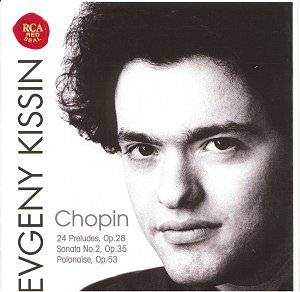CHOPIN 24 Preludes Op 28; Sonata No 2 in B flat minor
Op 35; Polonaise in A flat Op
53.
 Evgeny Kissin
Evgeny Kissin
 RCA Red Seal 09026 63535
2 [DDD] [67' 08"].
RCA Red Seal 09026 63535
2 [DDD] [67' 08"].

The Preludes have strong performances and are not therefore an example
of usual Chopin playing. The second has its theme too prominent at times
making the music sound somewhat unnatural. The fleetness of the third is
exemplary. But the solo line is again too strong as it is in the fourth prelude.
The music is not integrated ... the accompaniment is mainly relegated to
something of little importance. Number 5 is well executed but sounds trivial
and the following prelude is slightly too thoughtful. The mazurka that succeeds
it is shown as the banal piece it is. Number 8 sparkles magnificently at
times. But notes clatter without mercy as they do in number 9 which anticipates
the Funeral March of the Second Sonata with its bass trills.
This is the wrong interpretation. It lacks subtlety. Number 10 is also over
dramatic. Number 11 is pretty music and nothing else. The drama in number
12 is well captured but, by now, the clattering piano has become tiresome.
13 is nondescript but given a better reading could be quite poetic. 14 is
but thirty seconds of clatter and the following prelude, often called the
Raindrop, lacked evocation. The middle section was excruciating. I
imagined heavy footed, constipated elephants. 16 sparkles with exceptional
brilliance. The playing is very, very exciting ... absolutely stunning. 17
is Schubertian. 18 is full of exaggeration with crashing chords ... it is
all too much. 19 is a charming piece and here I enjoyed the interpretation
... shame about the last two chords. Number 20 is initially pounded out ...
again, there is no subtlety. Number 21 must have been known to Andrew Lloyd
Webber. Careful listeners will discover what I mean. 22 suffers from clatter;
23 approaches a Chopinese style while the final prelude, the best piece in
the set, almost works.
After this performance I listened to Ashkenazy's. What a difference. Ashkenazy's
is mature, responsible and has great insight and no excess.
The performance of the Sonata No 2 is good in parts if you can endure
the clattering piano. It makes Kissin's playing exaggerated and mannered
... or is that his playing? His playing lacks space. It is wild and unruly
at times. It is as if he is merely an exhibitionist rather than a servant
to the music. But he certainly has the measure of the scherzo ...
well, the robust parts at least. The overlong slow passages do not belong
here. As scherzo means a joke I cannot see how the extended slow
meanderings of this movement can amuse. The third movement, the Funeral
March, does not work in this performance. It lacks poise and stutters.
The big chords are too strong so that it sounds like caricature ... more
a scherzo than the preceding movement. Everything is exaggerated.
By contrast listen to the mature musicianship of Vladimir Ashkenazy.
Robert Schumann was criticised for calling this Sonata reckless music.
Was he right? The brief finale is an unsatisfactory piece. It has nothing
to say and does just that.
The Polonaise in A flat ends this recital with some more eccentric
playing which, at times, hints at insecurity.
Reviewer
David Wright
Performances

Recording


![]()